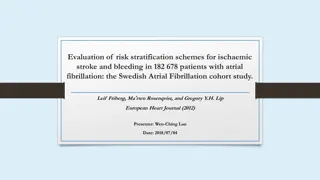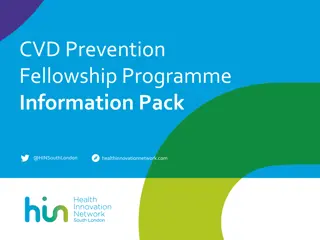Clinical Update
This clinical update presents the 2023 ACC/AHA/ACCP/HRS guideline for diagnosing and managing atrial fibrillation. It categorizes recommendations based on class of recommendation and level of evidence, ranging from strong to weak. Recommendations are supported by high-quality evidence from randomize
1 views • 46 slides
Comparison of Ablation vs. Antiarrhythmic Drugs for Atrial Fibrillation Treatment
In a follow-up analysis of the EARLY-AF trial, patients with paroxysmal atrial fibrillation were studied after cryoablation or antiarrhythmic drug therapy. Results showed lower incidence of persistent atrial fibrillation in the ablation group over 3 years, with fewer adverse events. Atrial fibrillat
4 views • 31 slides
Clinical Update
This clinical update provides recommendations for the diagnosis and management of atrial fibrillation adapted from the 2023 ACC/AHA/ACCP/HRS guidelines. It includes information on class strength of recommendations, levels of evidence, and phrases for writing recommendations based on the quality of e
0 views • 46 slides
Understanding Antiplatelet and Anticoagulation Therapy in Cardiology
This informative content covers the current practice guidelines and medication options for antiplatelet therapy in CAD patients, discussing different medications, optimal duration of therapy, CV risk assessment, and anticoagulation options in atrial fibrillation. It delves into the role of aspirin i
0 views • 31 slides
Understanding Anti-Arrhythmic Agents in Cardiac Care
Anti-arrhythmic agents are crucial in managing abnormal heart rhythms like atrial fibrillation and ventricular tachycardia. Causes of arrhythmias vary from heart anatomy changes to medication side effects. Factors like exertion, imbalances in blood chemistry, and medication use can trigger arrhythmi
0 views • 39 slides
Understanding Digoxin Pharmacology and Clinical Use
Digoxin, a cardiac glycoside, is utilized in managing congestive heart failure and atrial fibrillation due to its inotropic and chronotropic effects on the heart. It functions by inhibiting Na,K-ATPase, leading to increased intracellular calcium concentrations and augmented myocardial contractility.
5 views • 23 slides
Evaluation of Risk Stratification Schemes for Ischaemic Stroke and Bleeding in Atrial Fibrillation Patients
A study conducted in Sweden on 182,678 patients with atrial fibrillation aimed to investigate risk factors for stroke and bleeding. The research assessed the application of CHA2DS2-VASc and HAS-BLED schemes for stroke and bleeding risk evaluations. Data from the Swedish Atrial Fibrillation cohort st
0 views • 20 slides
Comparing Bleeding and Mortality Risks of Dabigatran vs. Rivaroxaban in Elderly Medicare Beneficiaries
A study by DJ Graham et al. compared the risks of stroke, bleeding, and mortality in elderly Medicare beneficiaries with nonvalvular atrial fibrillation treated with dabigatran or rivaroxaban. The study included over 118,000 patients and found that dabigatran was associated with a lower risk of majo
0 views • 9 slides
Prevalence of Cardiovascular Disease in Adult ESRD Patients: 2016 Data Report
The data report examines the prevalence of cardiovascular diseases in adult End-Stage Renal Disease (ESRD) patients in 2016 by treatment modality and age. It includes information on various cardiovascular conditions such as atrial fibrillation, acute myocardial infarction, coronary artery disease, a
2 views • 25 slides
Electrical Injuries: Causes, Effects, and Post-Mortem Findings
Dr. Shiuli from KGMU specializes in Forensic Medicine & Toxicology, focusing on the impact of electrical injuries such as ventricular fibrillation, thermal injuries, and post-mortem findings like external marks and histological changes. Detailed insights on path of current, causes of death, flash bu
0 views • 28 slides
Three-Year Outcomes of Left Atrial Appendage Closure vs. Oral Anticoagulation in Atrial Fibrillation
The PRAGUE-17 study compares the three-year outcomes of left atrial appendage closure (LAAC) versus direct oral anticoagulation in patients with atrial fibrillation. LAAC was found to be non-inferior to NOACs for the primary composite endpoint, with similar incidence rates for secondary endpoints. T
0 views • 21 slides
Atrial Fibrillation Overview: Symptoms, Treatment, and Management
Heart Failure (HF) is increasingly recognized as a cause of Atrial Fibrillation (AF). The goals of individualized therapy for AF include ventricular rate control, restoration of sinus rhythm, maintenance of sinus rhythm, and prevention of stroke. Hemodynamically unstable AF requires emergent convers
0 views • 29 slides
Understanding Cardiovascular Complications of Thalassaemia
Cardiovascular complications of thalassaemia can be categorized into iron overload-related issues such as myocyte failure and arrhythmias, and non-iron overload complications including pulmonary hypertension and atrial fibrillation. Cardiac iron accumulation poses a significant risk, leading to card
0 views • 36 slides
Perioperative Anticoagulation in Atrial Fibrillation Patients
A thorough exploration of perioperative bridging anticoagulation in patients with atrial fibrillation, discussing the benefits of anticoagulation, therapeutic options, comparison of literature, and application in moderate-risk patients. The use of warfarin in atrial fibrillation treatment, standard
0 views • 39 slides
Understanding Cardiac Utilization of Novel Oral Anticoagulants
Dive into the realm of cardiac anticoagulation, exploring the evolution from traditional methods like Warfarin to the modern use of Novel Oral Anticoagulants (NOACs). Discover the indications for long-term anticoagulation in conditions like atrial fibrillation and mechanical heart valves. Delve into
0 views • 46 slides
Understanding the Control of Heart Beat
The heart controls its own beat through the cardiac cycle initiated by the Sinoatrial node (SA node). This myogenic system allows the heart to contract and relax without the need for external impulses. The cardiac muscle responds to electrical waves, leading to synchronized contractions of the atria
0 views • 9 slides
Plasma Levels of NOACs in Patients with NVAF: Single Centre Study
This study aims to characterize the plasma levels of Dabigatran, Rivaroxaban, and Apixaban in patients with non-valvular atrial fibrillation (NVAF) who have been taking these drugs for more than 4 days. The research also assesses median trough plasma levels of these anticoagulants, as well as their
0 views • 18 slides
Cardiovascular Disease Prevention Fellowship Programme Information Pack
The Cardiovascular Disease Prevention Fellowship Programme by Health Innovation Network offers a comprehensive 7-month program for healthcare professionals to enhance their skills in cardiovascular disease prevention. The program includes clinical webinars, improvement collaborative sessions, and qu
0 views • 14 slides

















